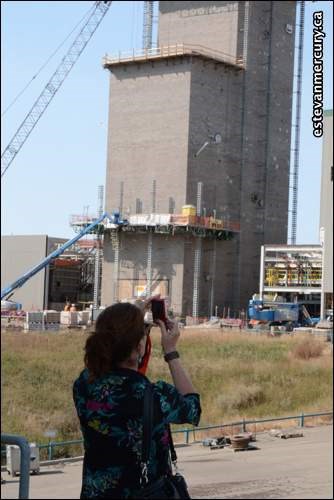Another busload of international visitors wended their way to Estevan last Thursday as a windup for the three-day International Energy Agency (IEA), conference that was hosted by the Petroleum Technology Research Centre in Regina.
The acronym for this year's session was IEAEOR (enhanced oil recovery). Since the delegates were focused on enhanced oil recovery technology, the clean coal carbon dioxide recovery system that is being constructed at Estevan's Boundary Dam No. 3 power generation unit addresses that topic in spades.
Using Boundary Dam's 110 megawatt No. 3 unit as the test electrical power generator for the world's first commercial sized project, it was expected that the event would draw a lot of international attention.
"This was the 33rd annual conference for this agency. Last year's was held in Vienna," said Norm Sacuta, communications co-ordinator for PTRC.
About 45 of the nearly 100 delegates who attended the conference climbed aboard the bus that brought them to Estevan to view BD3. A question and answer period followed with experts in the field of capturing and sequestering carbon dioxide underground and then reusing it as an agent to retrieve even more oil from oilfields that would otherwise be considered near depletion levels.
The delegates also visited the nearby Aquistore project where the CO2 will be stored miles underground until required for oil recovery. They then made their way back to the Goodwater region near Weyburn to see first-hand how current carbon dioxide gases are already being used for enhanced oil recovery at the Cenovus operated field. In this instance, the CO2 comes from a North Dakota gasification plant.
"The conference in Regina saw a good mix of researchers/scientists, another 20 per cent of them were engineers and to a lesser extent there were delegates who were from the private sector along with a few organizers and administrators," said Sacuta. "I would say there were 15 to 18 countries represented. A few of the delegates who had registered were unable to make it due to visa or some other international travel problems."
European and South American countries were well represented along with the Middle East, the PTRC spokesman said.
"They are interested in all aspects of the chain ... all enhanced oil recovery methods and of course the CO2 project is the latest and of most interest," he said.
Research papers and presentations filled up most of the delegates' time but they did spend one full day on CO2 recovery, learning what the studies of the characterization of the gas recovered would translate to once it was implemented.
"PTRC was the host, but we had a lot of help with organizing and sponsoring this event with SaskPower being one of the big sponsors and helpers of course. The Ministry of the Economy, Cenovus and the University of Regina were other big contributors," said Sacuta.
"It was a good focus session for the academics and industrial communities and those on the industrial and production side got a lot of solid information too," said Sacuta.
"There was a lot of discussion among the industry representatives, additional information was made available and the delegates were pretty enthusiastic over the high quality of the presentations. We had some great papers coming out of Austria and France, for instance," he added.
With interest building on the carbon capture and sequestration process, the delegates were pretty well convinced there would be even more interest building on the PTRC's research program and the development of intellectual properties that will accompany it.



